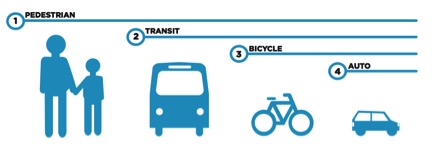~The Overriding Rule, “A New Theory of Urban Design” by Christopher Alexander, Hajo Neis, Artemis Anninou and Ingrid King, p22.
Rick Bernhardt, a truly magnificent city planner, retired recently after many years as the Executive Director of the Metropolitan Nashville-Davidson County Planning Department. He once told me that he started every presentation with that quote.
Over the years, I have thought often about this practice of Rick’s. It is such a simple thing to do, but so powerful in the way that it provides context and priorities to every conversation about planning in Nashville.
Planning is not just the big moves – the citywide 20-year vision plan, the zoning code re-write, or even a neighborhood plan. It is also all the little moves – re-striping after repaving a street, adding a stop sign, giving a permit to a new sidewalk café. And every one of these moves involves such a myriad of considerations, that it’s not surprising important pieces get lost.
Sometimes a simple policy, like Rick’s call to “heal the city,” can help us keep focused. For walkability, that simple call could be “Pedestrians First.”
Imagine the ripple effects if every city employee in the planning, transportation, and public works departments were given the mandate to consider “Pedestrians First” for every decision they make.
It’s already happening in some places. I first heard of this idea a few years ago in Vancouver, from Chief Planner Brent Toderian, and recently read more on the topic by 8-80 Cities founder, Gil Penalosa.
Chicago recently adopted this policy, about which Emily Badger writes, “That means that road crews heading out to resurface a street might consider ahead of time striping new bike lanes. Electrical engineers optimizing streetlights for car traffic will also think about crosswalk times. And construction teams rebuilding an entire boulevard may have to pause to consider pedestrian islands in the roadway, or bike parking on the sidewalk.” Chicago even refined the policy to: Pedestrians First. Then Transit. Then Bikes. Then Cars.

Image courtesy of Complete Streets Chicago Design Guidelines, courtesy of the Chicago Department of Transportation.
We could write volumes (or lots of blog posts) on the many factors that affect walkability, and many such volumes (and blog posts) have been written. The key is to get those factors considered at the right time and the right place.
An ethic of “pedestrians first” doesn’t mean that walkability will affect every decision in our cities and towns, but it would certainly make walkability affect more decisions than it does today. So let’s make it city policy to stop for a moment to consider – Will walkability will be affected? Could it be improved? – before making a decision. Pedestrians first.